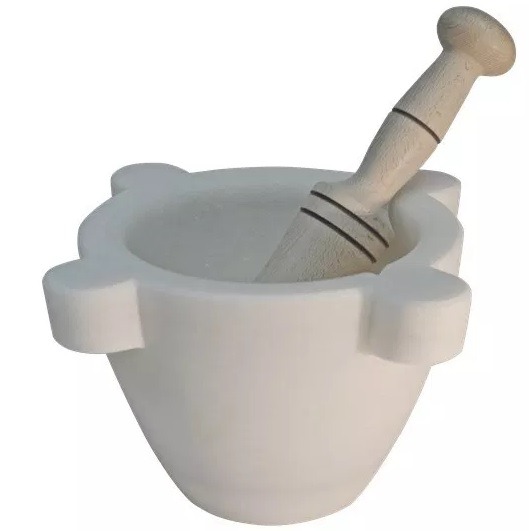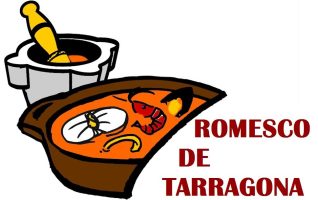About dried ancho peppers: it is advisable to opt for the dried ancho pepper –pebrot de romesco, as it is known locally- better without the paprika or another type of dry pepper called ñora. In the fish romescos recipes of this website, two dried ancho peppers are used for six people, but this amount could be decreased or increased to taste; obviously, by increasing the amount of pepper, we will obtain brighter red romescos. The dreid ancho pepper is used open, clean of seeds and lightly fried on both sides; Precisely in this task of lightly frying the pepper in the correct way, lies a large part of the merit of a good Romesco, since it is possible to burn it and finally obtain a bitter and disappointing dish.
However, and although it is something that requires a certain practice, this website recommends frying the dried ancho pepper, since this is where a large part of the success of a great Romesco lies (this technique is explained in the introduction to the recipe chapter).
If you want to go beyond, there are those who slightly trim some of the ends of the peppers once they are fried and cold, in order to eliminate possible more burnt black areas, which would add bitterness to the stew.
Despite this, some Romesco cooks prefer to use dried ancho peppers in other ways than frying them, which may be easier. To do this, the clean dried ancho peppers with their tails and seeds are rehydrated by immersing them in warm water for half an hour, then scraping the pulp and using it in the mixture, discarding the skin of the pepper. In other cases, the dried ancho peppers, also cleaned of tails and seeds, are boiled for five minutes in water, and they are used in the minced whole thus boiled, even with the skin. There is no shortage of cooks who use a commercial product called dried ancho pepper meat -or pulp- a few small bottles for sale that offer the meat of the dried ancho pepper already rehydrated, with the appearance of an intensely red cream, and that can be used on the basis of one heaped dessert spoon replacing each dried pepper.
Finally, a convenient option is to pass the dried ancho peppers -one by one- open and clean of tail and seeds through the microwave adjusted to its maximum power, at a rate of about 30 seconds for each pepper, allowing them to cool completely before passing them by the mixer. However, on this case it´s important to make previous tests with each type of microwave oven.
About extra virgin olive oil: especially when you start it is easy to put too much. For whatever reason, some historical Romesco recipes propose very high amounts of oil, which results in an overly oily Romesco that can frustrate the starter. For those meticulous who like to weigh all the ingredients: a recommended and fairly safe measure of oil is about 15 ml for each diner. It should be taken into account that the peppers or the bread can provide too much oil to the stew if they have not rested long enough on absorbent paper.
About nuts: some diners prefer that almonds and hazelnuts are present in the Romesco in thicker pieces, so that they can be chewed. To do this, it will be enough to not pass the nuts through the blender with the rest of the ingredients, but to crush them separately in a mortar until the desired grain thickness is obtained, then adding the result to the mixture as a whole. However, most cooks opt for a homogeneous and fine chop, so the nuts will be chopped thoroughly with all the rest of the ingredients in the mixer. It is also feasible to lightly fry almonds and hazelnuts before adding them to the Romesco mixture, even when using already roasted nuts.
Sometimes, there are those who add some pine nuts to the mix. If you want to try this, in any case you should put a moderate amount of pine nuts, reducing the amount of hazelnuts and almonds in the same proportion.
About garlic: Although garlic is a basic ingredient in Romesco, the amount can be adjusted to taste. Some cooks use garlic in Romesco previously fried, roasted or passed over the coals. You can also fry the garlic cloves with their skin on and peel them once cool, in order to obtain a finish similar to roasted garlic. In any case, the task of frying the garlic—or rather browning it—requires great attention, so that it does not burn and make the stew bitter. Finally, it can be a good solution to use half of the raw garlic cloves in recipes, and the other half of the garlic cloves cooked in the different ways mentioned.
About tomato: originally tomato was not used in Romesco, but if you want to add it, you always get a friendlier dish. Like garlic, it is usual to use the tomato in the previously roasted or braised Romesco, although it can be used simply fresh and grated, without the skin. When grated tomato is added, it may be necessary to add less wine, as the minced will be more diluted.
About fried ingredients of the Romesco base mixture: this important aspect is emphasized. Dried ancho peppers, bread, some (or all) of the garlic cloves and even roasted nuts are usually fried. In any case, it is essential to be very careful when frying these ingredients so that in no case will they burn them, as this could make the whole stew bitter. Dried ancho peppers in particular should be fried with the utmost caution (see the introduction to the Recipes chapter).
About potatoes: it is ideal to use if possible the most suitable kinds of potatoes for stews, given their greater consistency. Perhaps the ideal thing is to chop them into cracked pieces, that is, to start by cutting the potato piece, to end up breaking it by using a light lever with the knife, so that during cooking thickens the broth a little. In terms of size, the ideal is to make small pieces of potato, about the dimensions of a walnut, so that it is not necessary to use a lot of broth to cover them and also so that they cook more easily. In certain cases, it may be interesting to use the potatoes cut into slices approximately half a centimeter thick, as in this way they cook earlier and require less broth to be covered. The recipe for the quick Romesquet for two on this website is made with this last type of slicing on the potatoes. Finally: it may be a good idea to lightly fry the potatoes in the same casserole right at the beginning, after adding the oil, adding the Romesco base mix.
An interesting trick is to lightly fry the potato pieces in the oil before adding the Romesco base mix, which results in a tasty potato. In this case it is important not to fry the potatoes for more than a few minutes, so that they do not fall apart later in the stew.
About cooked beans: for optional use, it is ideal to use those sold already cooked in transparent glass jars, previously washed from the creamy medium in which they come inside the jar.
About amount of broth: one of the first challenges of the amateur chef who intends to make a good Romesco is to properly adjust the amount of broth in the stew, because at the beginning it is easy to put too much, making what has sometimes been popularly called a bathtub. In other cases, the Romesco may be too dry and let’s not forget that a good Romesco should ask for bread, as it is not for nothing that it is a stew. In any case, when you start cooking Romesco, making a bathtub is less of a problem, since the dish does not spoil and you can still eat it. Anyway, to get a good, attractive and balanced Romesco, you have to be very careful with the amount of broth you add to cooking, do it in a measured way and in small doses. As in so many other things, practice is the key. Before adding the broth to the stew, it may be a good idea to wash -with the broth itself- the container in which the base Romesco mix has been made.
About water: it is ideal that all the water that we use in any preparation on this website – also in the case of fish stock – is mineral, thus avoiding using tap water. This recommendation would generally be used for any activity in the kitchen. Although it may seem too meticulous a measure, the improvement in the final result is usually noticeable when mineral water is used, especially in certain dishes.
About the casserole: it is not necessary to use a specific casserole to make a good Romesco, although it is recommended that it be wide and with a low rim, among other things because this way it is easier to control the ideal amount of broth during cooking.
The traditional low clay pot is common in homes and is the one traditionally used in Romesco competitions, although it should be noted that it is not a non-stick product. Naturally, both the traditional low-rim aluminum casseroles frequently used in hospitality, as well as the modern high-performance non-stick low-rim casseroles, are a perfect alternative and are available in many sizes.
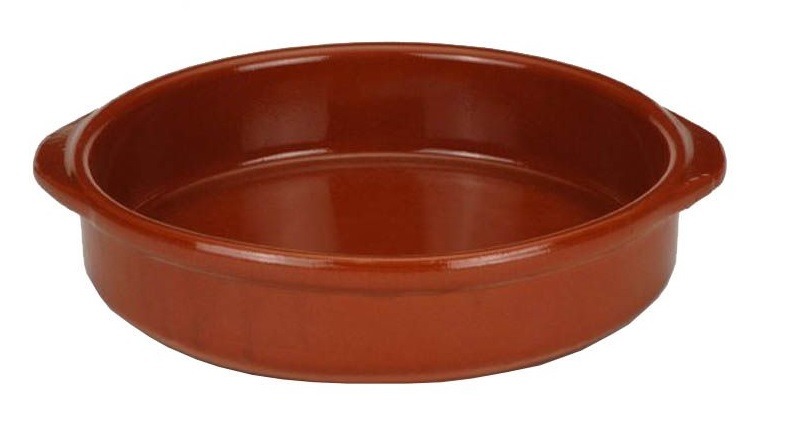
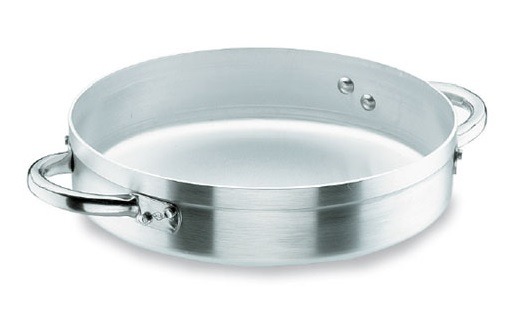
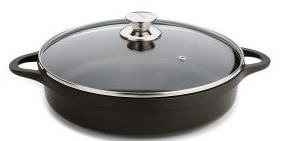
In the case of using clay pots with a gas fire or an oak charcoal stove, it may also be appropriate to use a heat diffuser. It is a metal disc of about six inches in diameter with holes on sale in hardware stores, which will be located between the fire and the base of the clay pot, preventing it from cracking or breaking with direct heat. This disc can also be used with the deep pans explained below, as it helps distribute the heat.
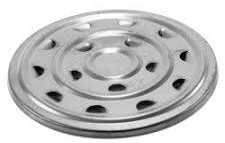
Although it is not a low casserole, it may be interesting to use an enameled deep pan. It is a container in the shape of a truncated cone with two handles and a typical black finish with white specks, which is widely used in various dishes and applications of Spanish gastronomy. Very affordable in price, it is marketed in many sizes, and its slightly concave shape makes it easy to fry the Romesco mix well at the bottom, being very sensitive to the intensity of heat applied to it. However, it is necessary to pay attention when cooking with this pan, since this container lacks non-stick properties.
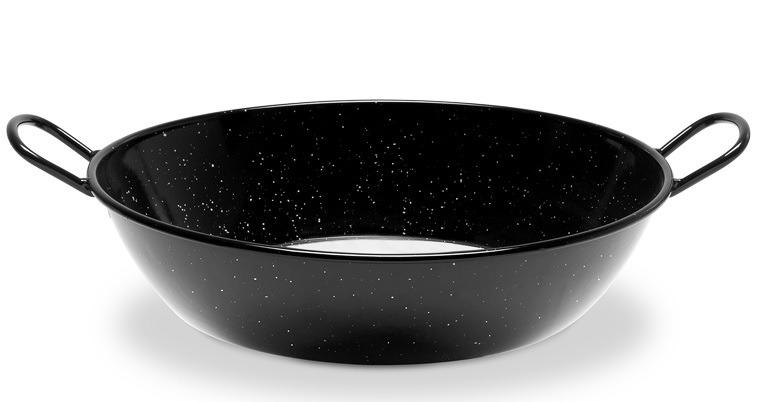
About the time of rest: like most stews, five or ten minutes of rest will be great for a Romesco. It is good not to overdo, as it can happen that the dish gets too cold and it could be a bit difficult to reheat a casserole of a good Romesco that has already rested.
About serve: originally the Romesco was taken in clay bowls. It is a good idea, because in this way the broth is more collected and accessible to the diner. However, if the Romesco has different ingredients (seafood, fish, potatoes, clams…) the bowl can be somewhat full, the dish being then a more practical and perhaps more elegant alternative. In any case, the proper serve of a good Romesco is also a very important phase of its preparation, and requires your time, patience and love.
About the use of the mortar: traditionally the Romesco base mince was made by working for a long time with a good mortar, an instrument that has become an icon of the Romesco. Today, the electric mixer or similar devices have relegated the mortar to a few cases. However, and for those who want to try, this website proposes a method to make the Romesco with mortar.
